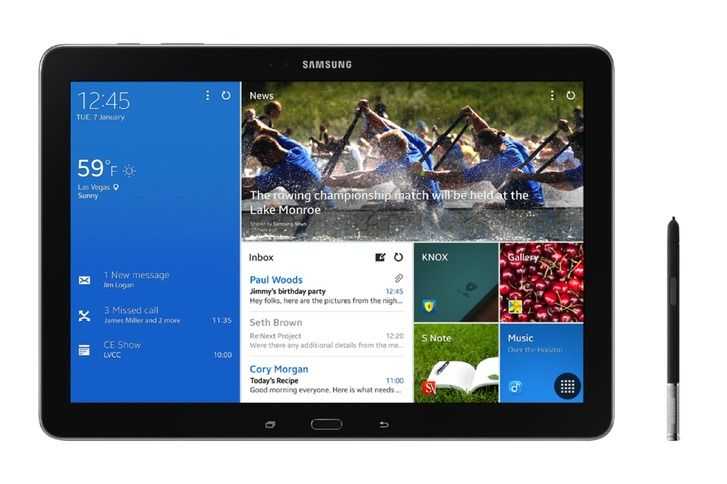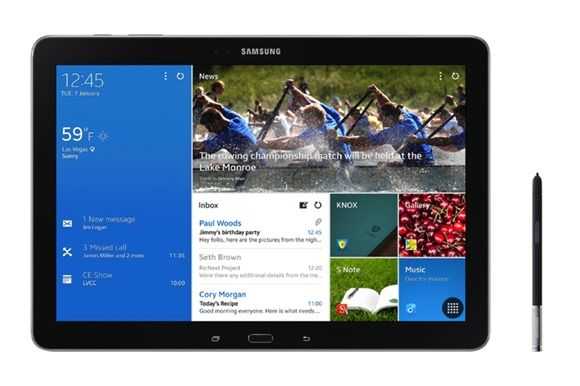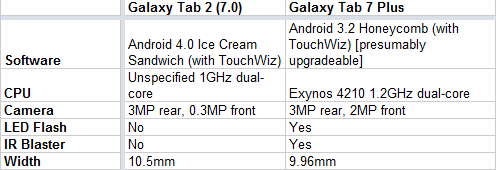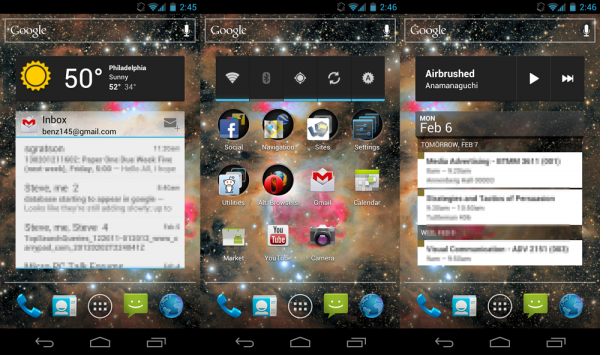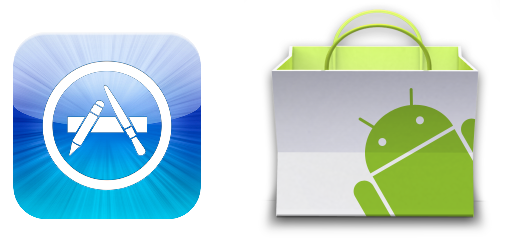Multi windowing, collaboration, ‘full size’ virtual keyboard, digitizer, and performance with a 12-inch screen. Sounds like an Windows Tablet right? No, Samsung have launched the Samsung Galaxy Note Pro, a 12-inch tablet running Android.
Tag Archive | "samsung galaxy"
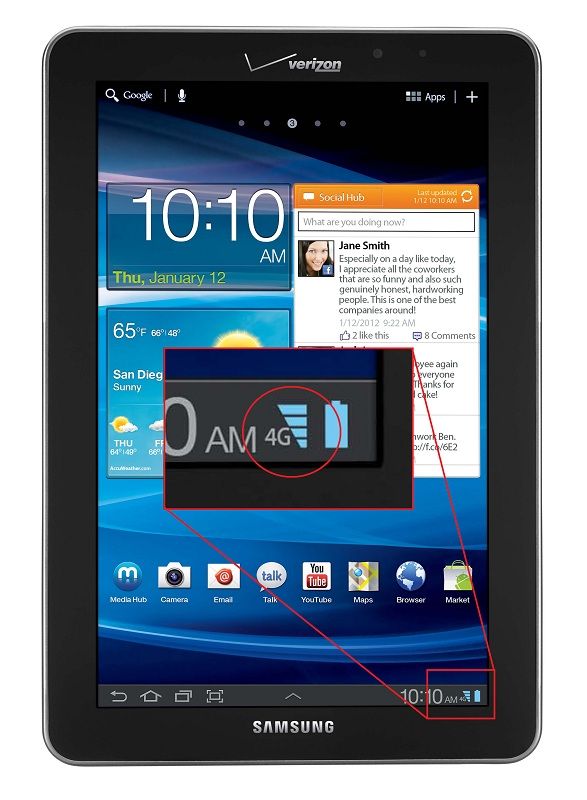
Breaking: Galaxy Tab 7.7 4G LTE Hitting Verizon on March 1st for $499, Finally
Posted on 28 February 2012
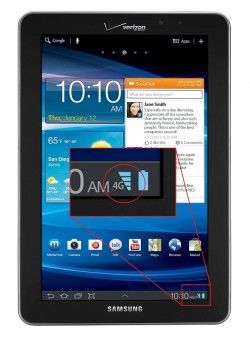 The Samsung Galaxy Tab 7.7 equipped with 4G LTE is finally touching down at Verizon starting in just two days. It’s been a long time coming, but starting March 1, you’ll be able to pick up the premium tablet for $499.
The Samsung Galaxy Tab 7.7 equipped with 4G LTE is finally touching down at Verizon starting in just two days. It’s been a long time coming, but starting March 1, you’ll be able to pick up the premium tablet for $499.
What do you get for $499? Well, first there’s the much lauded 7.7″ Super AMOLED Plus screen with 1280×800 resolution, then you’ve got a 1.4GHz dual-core CPU, 1GB of RAM, a 3.2MP rear camera (2MP front), and 16GB of storage, all contained inside of a sleek 7.8mm thick casing. This version of the Galaxy Tab also has that wonderful 4G LTE functionality that has proven time and again to be the speediest mobile data network in the ‘states.
The only show stopper? Verizon and Samsung indicate that the Galaxy Tab 7.7 will still be shipping with Android 3.2 Honeycomb. Given that the Galaxy Tab 2 (7.0), Galaxy Note 10.1, and Galaxy Tab 2 (10.1) were all just recently announced with Android 4.0 Honeycomb on board this is somewhat of a disappointment. Given the bad track record of updates for Android products — if I was in the market for a new tablet I might just wait until an official date for the release of Ice Cream Sandwich on the Galaxy Tab 7.7 before making a purchase decision.
The Galaxy Tab 7.7 was announced all the way back at IFA in September 2011. Since then, we’ve been watching carefully to see when the Tab 7.7 would make it stateside. The very last we had heard about the Galaxy Tab 7.7 release date was during CES 2012 in January when Verizon and Samsung said that the device would be arriving “in the coming weeks”. Wow, it’s been a long time coming! The $499 price point meshes well with our prediction from the other week, and unfortunately, so does the lack of Android 4.0 Ice Cream Sandwich!
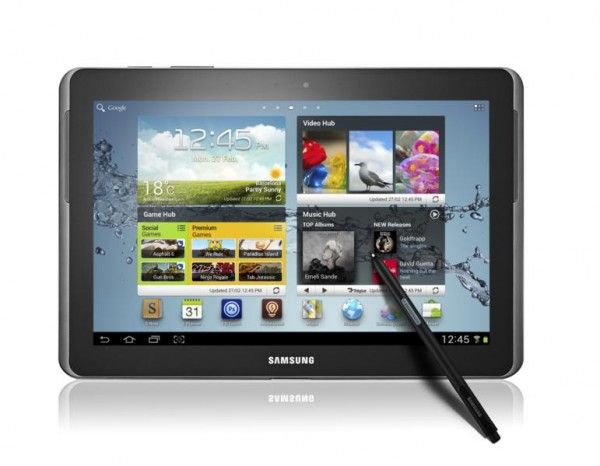
Samsung Galaxy Note 10.1 Brings Digital Inking and Photoshop to the Big Screen – Video
Posted on 27 February 2012
Samsung has just announced the Galaxy Note 10.1 tablet which features the same ‘S Pen’ active digitizer and stylus technology as found in the Galaxy Note smartphone. Back when the Galaxy Note was announced at IFA, Chippy and I bother remarked that we might enjoy the stylus functionality more on a tablet rather than a smartphone (thanks to the extra screen real estate, so I’m quite excited about this move from Samsung. Chippy has a hands on video of the Galaxy Note 10.1 straight form the MWC show floor:
With this announcement, Samsung says that they’re worked with Adobe to create a version of Photoshop Touch that is specially optimized for the S Pen functionality of the Galaxy Note 10.1. Photoshop Touch on the Note 10.1 will let you “transform images with core Photoshop features and combine multiple photos into layered images, make popular edits, apply professional effects, and more,” according to Samsung. Then there’s Adobe Ideas, also optimized for the S Pen, which allows you to create simply sketches and vector graphics. Samsung says that these S Pen optimized versions of Photoshop Touch and Adobe Ideas are exclusively pre-loaded on the Galaxy Note 10.1, though it seems the standard versions of these apps are currently available through the Android Market (see the links above).
In addition to these graphic-oriented apps, Samsung says that they’ve got a suite of apps to make the Galaxy Note 10.1 a powerful educational and productivity tool. The S Note app allows you to create a mashup of photos and annotation, and has templates such as meeting minutes, recipe, cards, diary, magazine, and more to help you become productive with minimal setup. Formula match and shape match functions in the S Note app allows the software to recognize mathematical symbols and shapes respectively to aid in math work diagram drawing, and more.
There’s no word yet on Galaxy Note 10.1 pricing or release date, but I’m just hoping this won’t turn into another multi-month fiasco as happened with the US release of the Galaxy Note and Galaxy Tab 7.7.
Aside from the S Pen functionality, a healthy dose of Android 4.0 Ice Cream Sandwich, and a MicroSD slot, the Galaxy Note 10.1 is unsurprisingly similar to the Galaxy Tab 10.1:
|
Network | HSPA? 21Mbps 850/900/1900/2100EDGE/GPRS 850/900/1800/1900 |
|---|---|
|
Processor | 1.4 GHz Dual-Core Processor |
|
Display | 10.1” WXGA(1280×800) PLS TFT |
|
OS | Android 4.0(Ice Cream Sandwich) |
|
Camera | ————-Main(Rear): 3 Megapixel Auto Focus Camera with LED Flash Sub(Front): 2 Megapixel Camera |
|
Video | ————-Codec: MPEG4, H.263, H.264, VC-1, DivX, WMV7, WMV8, WMV9, VP8 Format: 3GP(MP4), WMV(ASF), AVI, FLV, MKV, WebM Playback/ Recording: 1080p Full HD@30fps, 720p HD@30fps |
|
Audio | ————-Codec: MP3, OGG, WMA, AAC, ACC?, eAAC?, AMR(NB,WB), MIDI, WAV, AC-3, Flac Music Player with SoundAlive 3.5mm Ear Jack |
|
Value-added Features & Services |
————- Samsung TouchWiz / Samsung L!ve Panel |
|
S Pen Experience (S Note, S Planner) | |
| Samsung Apps | |
|
Samsung Hub – Readers Hub/ Music Hub/ Game Hub/ Video Hub | |
|
Samsung S Suggest (App recommendation service) | |
| Samsung ChatON mobile communication service | |
|
Samsung AllShare Play? | |
| Samsung Kies/ Samsung Kies air | |
| GoogleTM Mobile Services– Android Market™, Gmail™, YouTube™, Google Maps™, Syncing with Google Calendar™, Google Search, Google ? | |
| Adobe Apps – Photoshop Touch, Adobe Ideas | |
| Polaris document editor | |
| A-GPS(3G version) S-GPS(WiFi version) Glonass | |
|
Enterprise | ————-Exchange ActiveSync On-Device Encryption Cisco VPN(Virtual Private Network) Juniper Junos Pulse VPN |
|
Connectivity |
————- Bluetooth technology v 3.0 (Apt-X Codec support) |
|
Sensor |
Accelerometer, Digital compass, Light, Gyroscope |
|
Memory | 16/32/64GB User memory ? 1GB (RAM) microSD (up to 32GB) |
|
Dimension |
256.7 x 175.3 x 8.9 mm, 583g |
|
Battery |
Standard battery, Li-ion 7,000mAh |
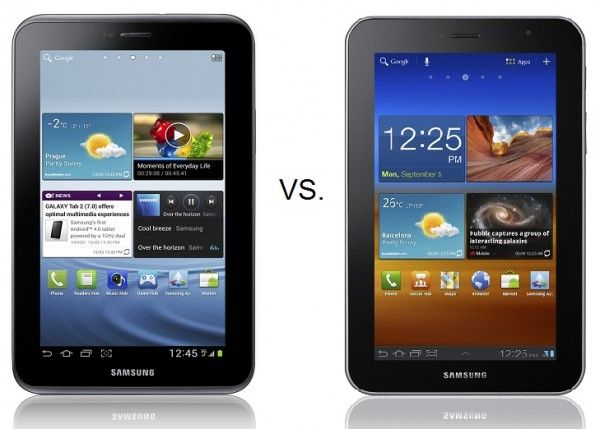
Samsung Announces Galaxy Tab 2 (7.0), It’s like the Galaxy Tab Plus Except… Worse.
Posted on 13 February 2012
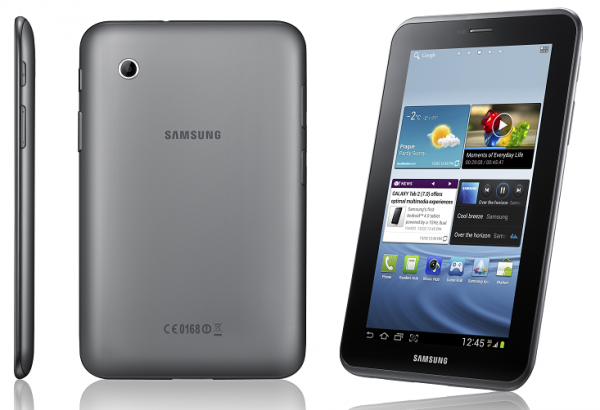 In what could only be called a baffling move, Samsung today announced the Galaxy Tab 2 (7.0). Through a press release, oddly titled ‘Samsung’s new GALAXY Tab 2 (7.0) offers optimal multimedia experiences in life‘, Samsung said that the new addition to the Galaxy Tab series would launch in March starting in the UK, then spread globally to other markets. Pricing was not confirmed, but I expect the Galaxy Tab 2 (7.0) to start around $450 for a WiFi-only model while US carriers may offer them for around $300. While the Galaxy Tab 2 (7.0.) is the first to bring the much lauded Android 4.0 Ice Cream Sandwich to Samsung’s 7″ form-factor, it also makes some rather strange omissions which make this feel more like a prequel than a sequel.
In what could only be called a baffling move, Samsung today announced the Galaxy Tab 2 (7.0). Through a press release, oddly titled ‘Samsung’s new GALAXY Tab 2 (7.0) offers optimal multimedia experiences in life‘, Samsung said that the new addition to the Galaxy Tab series would launch in March starting in the UK, then spread globally to other markets. Pricing was not confirmed, but I expect the Galaxy Tab 2 (7.0) to start around $450 for a WiFi-only model while US carriers may offer them for around $300. While the Galaxy Tab 2 (7.0.) is the first to bring the much lauded Android 4.0 Ice Cream Sandwich to Samsung’s 7″ form-factor, it also makes some rather strange omissions which make this feel more like a prequel than a sequel.
Recall that Samsung started their tablet series with the original Galaxy Tab 7. From there they went on to launch the Galaxy Tab 8.9, Tab 10.1, Tab 7.7 and eventually the Tab 7 Plus, which brought the 7″ tablet back up to par with a dual-core processor. If it wasn’t confusing enough already if Samsung wanted the Tab 7.7 or the Tab 7 Plus to be the successor to the original Galaxy Tab 7, things just got even more convoluted with the announcement of the Galaxy Tab 2 (7.0). Let’s have a look at the specs and see how it compares to the Tab 7 Plus:
Galaxy Tab 2 (7.0) Specs
|
Network |
HSPA? 21Mbps 850/900/1900/2100 |
|---|---|
|
Processor |
1 GHz Dual-Core Processor |
|
Display |
7” WSVGA(1024×600) PLS TFT |
|
OS |
Android 4.0(Ice Cream Sandwich) |
|
Camera |
Main(Rear): 3 Megapixel Fixed Focus CameraSub(Front): VGA for Video Call |
|
Video |
Codec: MPEG4, H.263, H.264, VC-1, DivX, WMV7, WMV8, VP8Format: 3GP, ASF, AVI, MP4, WMV, FLV, MKV, WebMPlayback/ Recording: Full HD@30fps, HD@30fps |
|
Audio |
Codec: MP3, AAC, AC-3, AMR, FLAC, MID, WMA, WAV, VorbisMusic Player with SoundAlive3.5mm Ear Jack |
|
Value-added Features |
Samsung TouchWiz/ Samsung L!ve Panel UX |
|
Samsung Apps |
|
| Samsung Kies / Samsung Kies air | |
|
Samsung Hub – Readers Hub/ Music Hub/ Game Hub/ Video Hub |
|
|
Samsung Hub Widget – Music Hub/ Game Hub/ Video Hub |
|
| Samsung S Suggest (App recommendation service) | |
|
Samsung ChatON mobile communication service |
|
| AllShare Play | |
| GoogleTM Mobile Services- Android Market™, Gmail™, Google Earth™, YouTube™, Google Maps™, Syncing with Google Calendar™ | |
| Polaris | |
| A-GPS, Glonass | |
|
Connectivity |
Bluetooth® technology v 3.0USB 2.0 HostWi-Fi 802.11 b/g/n, Wi-Fi Direct |
|
Sensor |
Accelerometer, Digital compass, Light Proximity(? Available on 3G version only) |
|
Memory |
8/16/32GB User memory ? 1GB (RAM) microSD (up to 32GB) |
|
Dimension |
193.7 x 122.4 x 10.5 mm, 344g |
|
Battery |
Standard battery, Li-ion 4,000mAh |
Also note that the Galaxy Tab 2 (7.0) can make phone calls (just like the Galaxy Tab 7 Plus). The press release offers an odd justification for this functionality: “With the voice call capability, the GALAXY Tab 2 (7.0) can be used just as easily as a phone, affording users the handy convenience of a second device in case they misplace their primary phone.”
What’s Missing?
 As mentioned, the Galaxy Tab 2 (7.0) is pretty much the same as the Galaxy Tab 7 Plus, except the Tab 2 has Ice Cream Sandwich. I call this announcement an odd move from Samsung because it seems as though they will be updating the Galaxy Tab 7 Plus with Android 4.0 Ice Cream Sandwich anyway. Once this happens, the Tab 7 Plus will actually have more features than the Tab 2 (7.0). Here are the (current) differences between the two:
As mentioned, the Galaxy Tab 2 (7.0) is pretty much the same as the Galaxy Tab 7 Plus, except the Tab 2 has Ice Cream Sandwich. I call this announcement an odd move from Samsung because it seems as though they will be updating the Galaxy Tab 7 Plus with Android 4.0 Ice Cream Sandwich anyway. Once this happens, the Tab 7 Plus will actually have more features than the Tab 2 (7.0). Here are the (current) differences between the two:
Yes, you’re reading that right: the Galaxy Tab 2 has a slower processor, a lower resolution front camera, no flash, no IR blaster, and is thicker (same battery capacity just in case you were wondering). How exactly Samsung arrived at the conclusion that the Galaxy Tab 2 (7.0) should be considered the successor to the original Tab 7, while concluding that the Tab 7 Plus was somehow unworthy of the title, is beyond me.
In all fairness, the Galaxy Tab 2 (7.0) does has a few tricks up it’s sleeve that the Galaxy Tab 7 Plus doesn’t have, but these are all software based and can be ported over when the Tab 7 Plus receives the Android 4.0 Ice Cream Sandwich upgrade.
Unless the Galaxy Tab 2 (7.0) is going to sell for significantly less than the Tab 7 Plus (and I don’t think it will), then I really don’t quite understand what Samsung hopes to gain with this launch.
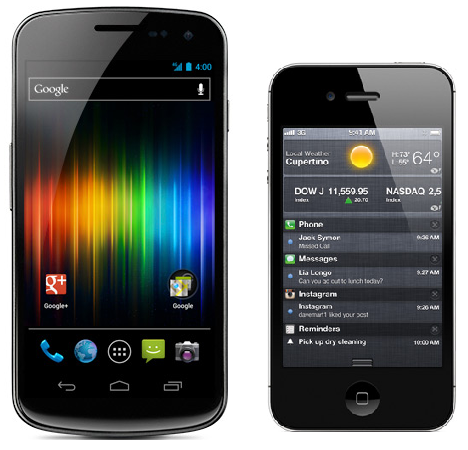
Samsung Galaxy Nexus: The Closest I’ve Come to Switching to Android
Posted on 12 February 2012
I’ve been using the iPhone for three generations now — starting with the iPhone 3G, then the iPhone 3GS, and finally the iPhone 4 which is my current companion. I’m finally due for an upgrade and I must say that I’ve come closer than ever before to picking an Android phone (specifically the Galaxy Nexus) over an iPhone, but it just wasn’t meant to be and I’ll explain why. Be sure to note that what’s important to have in a phone for me might not be the same for you; I’m just laying out my thoughts here as to why the Galaxy Nexus has been the phone that has come the closest to tempting me over to Android.
Android 4.0
 Android 4.0 Ice Cream Sandwich feels like the first truly full package in the history of Android. Finally there’s good hardware acceleration and enough performance for a nearly smooth home screen. This hasn’t quite translated over to all apps just yet. Android finally seems to have all of the vital default apps and has long included a turn-by-turn navigation app that blows Apple’s Maps app out of the water. Google just launched the Chrome Beta browser which offers a rich browsing experience which should have been included in Android long ago. Photos can now be robustly edited right in the gallery without scouring the Android Market for the right app. Home screen folders are extremely fast and a pleasure to use, while resizable widgets further the level of flexibility and customization. There’s better battery and data analysis, and much more. This has all come together in bits and pieces over the last few years as Android has grown, and 4.0 is the first time it feels like a complete package to me.
Android 4.0 Ice Cream Sandwich feels like the first truly full package in the history of Android. Finally there’s good hardware acceleration and enough performance for a nearly smooth home screen. This hasn’t quite translated over to all apps just yet. Android finally seems to have all of the vital default apps and has long included a turn-by-turn navigation app that blows Apple’s Maps app out of the water. Google just launched the Chrome Beta browser which offers a rich browsing experience which should have been included in Android long ago. Photos can now be robustly edited right in the gallery without scouring the Android Market for the right app. Home screen folders are extremely fast and a pleasure to use, while resizable widgets further the level of flexibility and customization. There’s better battery and data analysis, and much more. This has all come together in bits and pieces over the last few years as Android has grown, and 4.0 is the first time it feels like a complete package to me.
The saddest part about all of this is how hard it is to get your hands on Android 4.0 Ice Cream Sandwich. Google has crafted this seemingly complete package, but less than 1% of users have access to it right now! I’m actually limited to the Galaxy Nexus if I want a top-end phone that also runs Android 4.0 at the moment.
Camera
 The camera app in Android 4.0 is super fast in both launching and taking consecutive photos. Unfortunately, I still find that all Android handsets that I’ve tested have lacked in camera quality (for both stills and video) when compared to the iPhone 4, often despite higher megapixel ratings. For me, camera quality is more important than speed. The new panorama mode in the Android 4.0 camera app is neat, but I find that I can achieve better results by taking individual photos, then stitching them together on the computer. It’s a shame that Nokia never got into the Android ecosystem as they’ve long been heralded as having some of the best optics in the mobile industry.
The camera app in Android 4.0 is super fast in both launching and taking consecutive photos. Unfortunately, I still find that all Android handsets that I’ve tested have lacked in camera quality (for both stills and video) when compared to the iPhone 4, often despite higher megapixel ratings. For me, camera quality is more important than speed. The new panorama mode in the Android 4.0 camera app is neat, but I find that I can achieve better results by taking individual photos, then stitching them together on the computer. It’s a shame that Nokia never got into the Android ecosystem as they’ve long been heralded as having some of the best optics in the mobile industry.
The iPhone 4S camera is supposed to be even better than the iPhone 4 camera with 8MP instead of 5MP and reworked optics. If I can achieve photos like the following with the iPhone 4, then I’m looking forward to what the iPhone 4S has to offer:
Notification System
I’ve said it before and I think it’s still true today: Android is the best at managing notifications, while iOS is the best at delivering them. Between Android 4.0 and iOS 5.0, Android absolutely wins when it comes to managing notifications — you can toss away individual notifications or dismiss them all at once if you’d like. Tapping on a notification takes you directly to the item you are being notified about. All of this is better than how iOS does it. However, Apple’s push notification system is best in class. I don’t understand why Google doesn’t have push Gmail through the official Gmail app. Side-by-side with the Galaxy Nexus, my iPhone 4 shows changes to my inbox almost instantly, while the Galaxy Nexus doesn’t do anything until significantly later, unless manually refreshed. I can literally receive, respond to, and be done with an email on my iPhone 4 before it even arrives on the Galaxy Nexus. For some people, getting notifications instantly isn’t a big deal, but as someone who works on the web it’s a big advantage and one that I can’t easily give up.
Screen Size
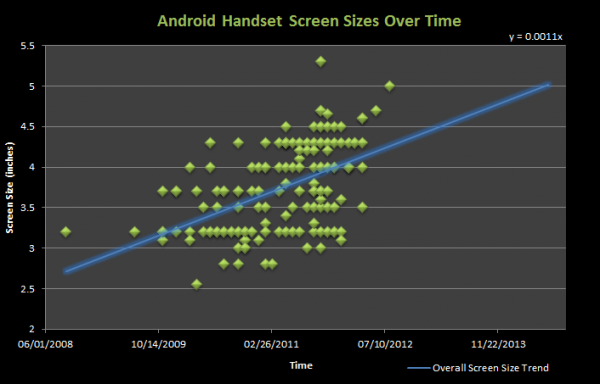
If you follow Carrypad regularly, you’ll know that I’ve got some gripes with 4″+ screens. One-handed usability is important to me because I’m frequently on the go. The 3.5″ screen of the iPhone (all versions of it) is far more comfortable in my hand than anything 4″ and above. The Galaxy Nexus, at 4.65″, is just too big to be used comfortably in one hand for me. Everyone’s hands are different sizes, so everyone has a different limit, but with the massive-screen fad that’s been growing in Android over the years, it’s almost impossible to get a top-end Android phone in a size less than 4″. If the Galaxy Nexus came in any size 4″ or less, I’d be far more inclined to pick it over the iPhone 4S.
Customization
This is one of Android’s greatest strengths, but it always runs the risk of being over-complicated. I’m the kind of person who loves to tinker with their gadgets and get them to work just the way I’d like. On the iPhone, this urge is satisfied with jailbreaking, which enhances the customizations you can make on iOS, but it’s not much compared to what you can do on Android. With Android 4.0 on the Galaxy Nexus, I can fit tons of apps efficiently on one page with folders. On other screens, I’ve got at-a-glance access to my calendar, weather, inbox, and music player. It’s nice to be able to do much of what I need to right from the homescreen instead of jumping through hoops between apps. This category is a major win for the Galaxy Nexus.
Apps
There’s no denying that there are some great apps on Android, but Apple’s iOS App Store still has a greater number of apps than the Android Market. When we’re talking about hundreds of thousands of apps in each store, the aggregate hardly matters. Where iOS has the real advantage is in quality and consistency. Because Apple has strict guidelines, most apps are intuitive and work well without crashing. When it comes to apps from the Android Market, you might have two great apps, but they might have two completely different interface approaches — one app trying to emulate an iOS-like ‘everything on screen’ style and the other trying to do the Android thing by hiding features away in long-presses and hidden menus. Alone, each of these is arguably as good as the other, but when you have to jump between apps that go back in forth in their interface approach, the user interaction aspect of it becomes increasingly convoluted, and this is something I quite dislike.
Availability
If everything above held an advantage for the Galaxy Nexus, there would still be one huge issue for me choosing it over the iPhone 4S — availability. I’m on AT&T, and the Galaxy Nexus is decidedly not available for purchase. AT&T has not one Android 4.0 ICS phone available at the moment, which means the best I could do is buy one of the top-end Android phones then wait and hope that it would receive an ICS upgrade. If Google thinks the Galaxy Nexus and Android 4.0 is such a great pair, they’ve got to do a better job of making it available for people to actually purchase it. The only way for me to actually get my hands on the Galaxy Nexus would be to switch carriers or buy an expensive unlocked version of the phone without a subsidy from my carrier.
So, Google, you almost had me on this one, but unfortunately I’ve made up my mind to continue with the iPhone — for now anyway. Fix the stuff above that needs it; you’ve got two years to work on it before there’s another chance to convert me.
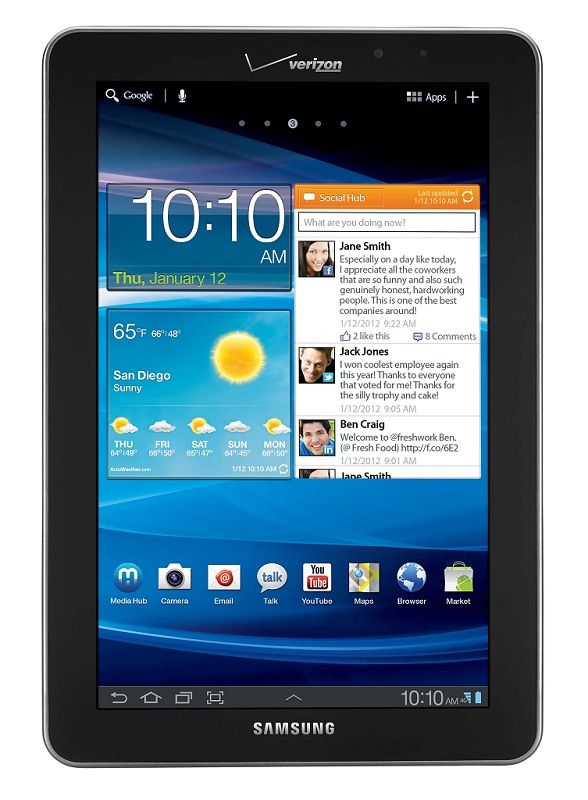
Samsung Galaxy Tab 7.7 4G Officially Coming to US “In the Coming Weeks”
Posted on 02 February 2012
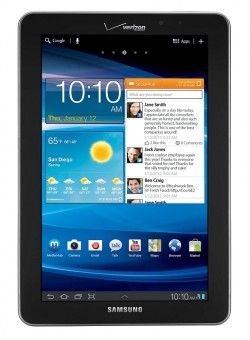 The Samsung Galaxy Tab 7.7 is officially going to land on U.S. shores with a 4G LTE variant that will be carried by Verizon. It’s great to finally have this confirmation straight from Samsung/Verizon as it’s been a whopping 5 months since the Galaxy Tab 7.7 was announced during IFA in September 2011.
The Samsung Galaxy Tab 7.7 is officially going to land on U.S. shores with a 4G LTE variant that will be carried by Verizon. It’s great to finally have this confirmation straight from Samsung/Verizon as it’s been a whopping 5 months since the Galaxy Tab 7.7 was announced during IFA in September 2011.
Since that original announcement, we’ve heard conflicting reports about Samsung’s plans for release in the US. At the end of September 2011, the Galaxy Tab was spotted rolling through the FCC, cementing our belief that it would eventually see a US release, however, months went by after the FCC discovery with no announcement from Samsung.
The Samsung Galaxy Note, which was announced at the same time, also had a relatively lengthy history of ambiguous US release plans. Recently, Samsung announced that the Galaxy Note would be hitting the US carried by AT&T.
Samsung and Verizon made the announcement that the 4G LTE equipped variant of the Galaxy Tab 7.7 would arrive in the US during CES. The announcement says that this will happen “in the coming weeks”, so we expect to hear more soon. Unfortunately, no Galaxy Tab 7.7 release date or price accompanied the announcement.
The Tab 7.7 is currently the most premium 7″ tablet on the market with a 1280×800 AMOLED screen, a 1.4GHz dual-core CPU, and now, 4G LTE connectivity. At 340 grams and 7.9 mm thick, it’s also one of the lightest and thinnest. The only thing it’s really missing is Android 4.0 Ice Cream Sandwich, though Samsung says they’ll update the Galaxy Tab 7.7 to ICS eventually. Currently the device runs Android 3.2 Honeycomb out of the box, and it doesn’t sound like it’ll see the ICS upgrade prior to its Verizon US debut. Thanks to these premium features, you can expect to pay a premium price when the Tab 7.7 launches on Verion. Given their current tablet lineup and pricing, I’d expect the 16GB version of the Galaxy Tab 7.7 to be priced between $500 and $600.
It’s interesting to note that Samsung has decided to launch the Galaxy Tab 7.7 on Verizon and the Galaxy Note on AT&T. I’m not sure if there’s a strategy to that move (it could just be to keep the carriers complacent with exclusives), or if it was just the roll of the dice. No word on this point if either device will go cross-carrier, but I suppose time will tell.
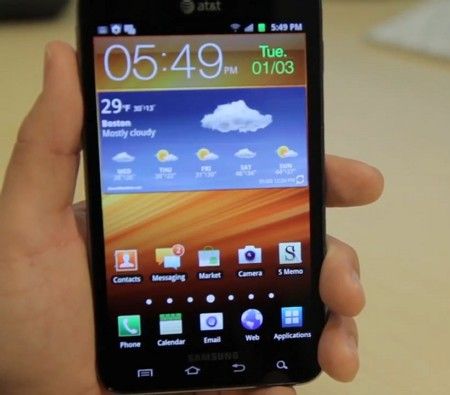
Samsung Galaxy Note Confirmed for AT&T, Available in the Coming Weeks
Posted on 10 January 2012
 The ever-interesting Samsung Galaxy Note has finally been officially confirmed for release on the AT&T network. AT&T announced the Note in a press release yesterday, alongside several other devices. According to the release, the Galaxy Note is “planned for availability in AT&T stores and online in the coming weeks”. Hopefully, those “weeks” won’t slip into months! Pricing information has not been released, but based on the MSRP of the phone, $299-$399 is a safe bet. It’s unclear at this point if Verizon will eventually offer the Galaxy Note or if this is an exclusive for AT&T.
The ever-interesting Samsung Galaxy Note has finally been officially confirmed for release on the AT&T network. AT&T announced the Note in a press release yesterday, alongside several other devices. According to the release, the Galaxy Note is “planned for availability in AT&T stores and online in the coming weeks”. Hopefully, those “weeks” won’t slip into months! Pricing information has not been released, but based on the MSRP of the phone, $299-$399 is a safe bet. It’s unclear at this point if Verizon will eventually offer the Galaxy Note or if this is an exclusive for AT&T.
The Galaxy Note, which is the first modern Android phone to incorporate an active digitizer and stylus, was announced what seems like ages ago at IFA in September. Since then, the Note has gone gone on sale in Europe and elsewhere, but US folks have been unable to get their hands on the phone except through pricey importers.
The Galaxy Note’s active digitizer allows the user to input highly accurate hand-written text. Such functionality has long before been seen on tablet PCs and a few Android tablets, but the Note is the first to include the technology in an Android phone. Chippy has a mini-review of the Galaxy Note alone with photos and videos if you’re interested in the device.
When the Note was first launched, I was a bit annoyed at the massive 5.3″ screen. I still feel like screens beyond 3.75″ or 4″ negatively affect the ergonomics of a phone, but I will admit that in the case of the Galaxy Note, I’m singing to a different tune. The stylus means that you’ll be using the phone with two-hands regardless (one to hold the phone, one to write with), so the argument against a huge screen is somewhat averted. The compromise to enable a large writing area is also one that I might be willing to make (and I know plenty of others who would be happy to make).
Interestingly, in a video accompanied by the AT&T press release, the stylus and active digitizer almost went unmentioned, save for a few seconds at the end. In most of the European advertising material, the stylus was front and center as the most important part of the phone. It seems that AT&T knows that most US consumers (that doesn’t include tech nerds like myself and you!) are looking for an iPhone experience, otherwise they’d be pushing this unique feature much harder.

Samsung Galaxy Note Confirmed for AT&T, Available in the Coming Weeks
Posted on 10 January 2012
 The ever-interesting Samsung Galaxy Note has finally been officially confirmed for release on the AT&T network. AT&T announced the Note in a press release yesterday, alongside several other devices. According to the release, the Galaxy Note is “planned for availability in AT&T stores and online in the coming weeks”. Hopefully, those “weeks” won’t slip into months! Pricing information has not been released, but based on the MSRP of the phone, $299-$399 is a safe bet. It’s unclear at this point if Verizon will eventually offer the Galaxy Note or if this is an exclusive for AT&T.
The ever-interesting Samsung Galaxy Note has finally been officially confirmed for release on the AT&T network. AT&T announced the Note in a press release yesterday, alongside several other devices. According to the release, the Galaxy Note is “planned for availability in AT&T stores and online in the coming weeks”. Hopefully, those “weeks” won’t slip into months! Pricing information has not been released, but based on the MSRP of the phone, $299-$399 is a safe bet. It’s unclear at this point if Verizon will eventually offer the Galaxy Note or if this is an exclusive for AT&T.
The Galaxy Note, which is the first modern Android phone to incorporate an active digitizer and stylus, was announced what seems like ages ago at IFA in September. Since then, the Note has gone gone on sale in Europe and elsewhere, but US folks have been unable to get their hands on the phone except through pricey importers.
The Galaxy Note’s active digitizer allows the user to input highly accurate hand-written text. Such functionality has long before been seen on tablet PCs and a few Android tablets, but the Note is the first to include the technology in an Android phone. Chippy has a mini-review of the Galaxy Note alone with photos and videos if you’re interested in the device.
When the Note was first launched, I was a bit annoyed at the massive 5.3″ screen. I still feel like screens beyond 3.75″ or 4″ negatively affect the ergonomics of a phone, but I will admit that in the case of the Galaxy Note, I’m singing to a different tune. The stylus means that you’ll be using the phone with two-hands regardless (one to hold the phone, one to write with), so the argument against a huge screen is somewhat averted. The compromise to enable a large writing area is also one that I might be willing to make (and I know plenty of others who would be happy to make).
Interestingly, in a video accompanied by the AT&T press release, the stylus and active digitizer almost went unmentioned, save for a few seconds at the end. In most of the European advertising material, the stylus was front and center as the most important part of the phone. It seems that AT&T knows that most US consumers (that doesn’t include tech nerds like myself and you!) are looking for an iPhone experience, otherwise they’d be pushing this unique feature much harder.
 |
| |||
 |
| |||
 |
| |||
 |
| |||
 |
| |||
 |
| |||
 |
| |||
 |
| |||
 |
| |||
 |
|

